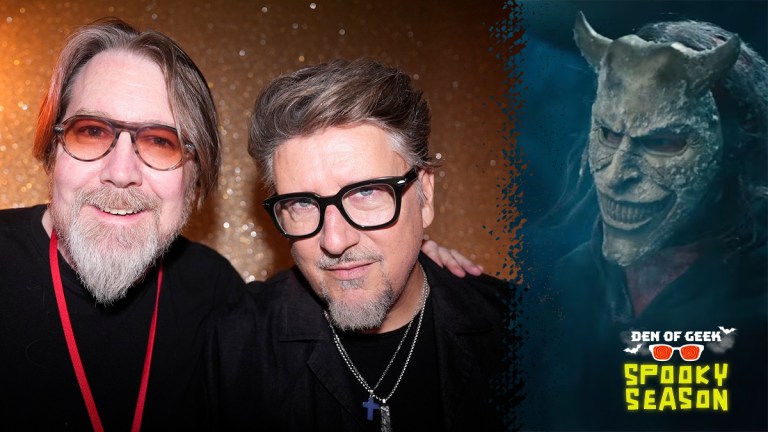Black Phone 2: The Creepy Real-Life Experience That Brought the Grabber Back
Exclusive: Director Scott Derrickson and co-writer C. Robert Cargill reveal why they envision Hell as ice in Black Phone 2, and how a creepy childhood experience inspired the movie's setting.

Longtime collaborators and horror connoisseurs Scott Derrickson and C. Robert Cargill are not big on doing sequels. Granted, a lot of folks in Hollywood say that before making one, but few have such a rich history of walking away from the alleged sure-thing. Whether it was turning down the chance to helm Sinister 2 or having much at all to do with Marvel’s eventual Doctor Strange continuation, Derrickson and Cargill always found themselves searching for greener, fresher pastures—including eschewing MCU money in favor of making a mean, gritty little chiller that starred Ethan Hawke as a child predator in a mask: 2021’s The Black Phone.
Even so, when the specter of a Black Phone 2 came around, neither Derrickson or Cargill could let this ghost go—particularly after author Joe Hill called Cargill up with his own lucid dream of an idea that would expand the narrative of the first film, which itself is based on a short story by Hill.
“The core pitch was one line,” screenwriter Cargill recalls with a slowly spreading grin when we catch up with them at Fantastic Fest. “A phone rings, Finney answers, and it’s the Grabber calling him from Hell. And I was like, ‘Oh fuck yeah.’”
It’s a stark image, one which has become the central conceit of Black Phone 2’s marketing strategy. Our core survivor and hero of the first film, Mason Thomas’ young Finney, is now a teenager who’s lived to see the 1980s. He’s defeated the Grabber and witnessed Hawke’s repellent manifestation of real-world evil consigned to the gates of perdition. Yet in a lonely telephone booth on a deeply frigid night, a phone rings, and outside the booth, the Grabber’s sinister mask hovers against the frozen glass like he was the devil himself. Finney picks up.
“Joe went in and had all of these smaller ideas,” Cargill continues. “Some of them are in the movie, some of them didn’t quite work, because he was just spitballing, it hit him like a truck, but he called me up, and I was like, ‘You have to call Scott.’” They had a movie to make.
Sitting in our Austin studio the morning after Black Phone 2‘s world premiere, Derrickson and Cargill seem appropriately pleased with the turn of events for their sequel, which by design leap-frogs past the first film’s 1970s setting and aesthetics for a 1982 follow-up. In the new movie, Finney is now in high school, as is little sister Gwen (Madeleine McGraw), the latter of whom takes on a more pronounced role since she too becomes bedeviled by bleak dreams involving their mother, the Grabber, and a winter camp nestled in the Rockies.
The setup obviously provides a different context for the sequel, and yet it was one that Derrickson and Cargill knew intimately from their own childhoods in the same era. The wintertime Christian camp proved especially vital to painting with an authenticity and nostalgia that would be alien to most.
“Winter camps in the Rockies are something I went to as a teenager,” director Derrickson reveals to us. “I [brought in] specifically the dangerousness of the weather, and the idea that there are these old structures that were old in 1982. They would rattle in the storms; they didn’t feel safe when you were in them, and you probably weren’t as safe as you thought you were. Being 16 or 17 years old, there’s a heightened sense of existence when you’re in an environment like that, especially at night when it can be 20 or 30 degrees below zero in a storm. I think all of that, and the spiritual texture with it [in] Gwen’s dreams, and the religious conversations, all of that was very real to my high school experience.”
It also came out of a central conceit he and Cargill settled on as writers: they would have the Grabber tell Finney “Hell isn’t flames, it’s ice,” a visual motif informed almost entirely by Dante’s Ninth Circle of Hell in The Divine Comedy.
Says Derrickson, “The Dante reference is really the thing. I love Dante’s book. I’ve read the whole Divine Comedy, but the Inferno is really the part people gawk over, and I think the idea that of the Ninth Circle of Hell being ice where the worst of the worst are—they are the betrayers, and there is something about the Grabber being a betrayer to the kids, to his brother, and being the worst kind of person that there is—and the inversion of the flame mythology with the ice mythology, that just made sense to me.”
Yet if Derrickson was drawing on his own youth, Cargill also brought in his own eerie real-life experience as a counselor at a summer camp.
“I worked at a Christian youth camp, so a lot of the rules and texture of how the camp works came from my experiences of working at these camps,” Cargill says. Some of this was from the lighter side of nostalgia, such as counselors in the 1980s often creating fake names just for their campers (Cargill muses there are adults out there right now who don’t know their beloved Counselor Bogie co-wrote that Doctor Strange movie they saw decades later). But it was far from all fun and games.
“I had a horror movie experience at one of those camps,” he confides. “It was literally on a weekend where most of the kids were gone, and I was one of the only counselors on, taking care of the stay-over kids staying for more than a week, and we had a guy in a mask break into the girls’ cabin,” Cargill says. “And when a girl walked in, she saw a guy in a mask with a weapon, and she took off. We had to grab the kids and get the rifles from the rifle range and hole up at the main house while we called the police and had them scour the grounds.”
They never did find the masked intruder. And for the rest of the summer, children and counselors alike dreaded “there was some masked guy out in the woods.”
An experience like that can help explain why despite intentionally returning to the well-worn genre staple of a camp setting—albeit at winter instead of summer—there is a tactile chilliness to Black Phone 2 that is more than just the temperature on set.
Much of this, again, comes down to Hawke’s performance as the Grabber, which is less frequently on screen in Black Phone 2 but constantly felt. According to Derrickson, it was something Hawke approached with at least mild trepidation since. In his mind, the actor had never committed to a sequel before either—an interesting perspective since Hawke of course co-wrote and starred in Richard Linklater’s Before Sunset and Before Midnight. “That doesn’t count, I wrote it!” Hawke told his horror director.
Like Derrickson and Cargill though, Hawke became enthralled with the idea of a Grabber spat back out from Hell with what little shreds of humanity he had being stripped away. All that’s left is the demonic. The conception of an ‘80s child killer coming back in the dreams of his intended victims—Gwen and Finney—obviously owes a debt to Freddy Krueger. However, the co-writers of Black Phone 2 note significant differences from their biggest influence.
“The thing is we are adjacent to Nightmare on Elm Street,” acknowledges Cargill. “Of course it was a big inspiration. Dream Warriors in particular was the big inspiration. We love Dream Warriors. A Nightmare on Elm Street is the best in the series, but Dream Warriors is everyone’s favorite for a reason. It’s just such a great movie. But here [the Grabber’s] rules, his powers, he isn’t able to do something like Freddy Krueger does. Freddy Krueger is a vengeful spirit, who is wreaking havoc on people who had nothing to do with him by the end of the series. He’s just killing to kill, and the Grabber is a singular being of revenge that wants to get revenge on one person in the universe, and he wants to hurt that person so badly.”
Derrickson also points out that the reason they cast Hawke is what makes this a different, perhaps even more unseemly beast.
“The biggest difference between the two characters is how talkative the Grabber is,” the director considers. “Words are his weapons, inciting fear, the first part of his sadistic torture is scaring them with his language. That’s why we got Ethan to do this movie, because he is such an eloquent speaker and interpreter of lines, and he says a lot in this movie. He says a lot in the first movie. He’s not running around doing one-line quips. Instead he’s speaking perfect paragraphs about the nature of Hell itself.”
It was core to making a sequel that neither Derrickson or Cargill, nor they hope the audience, can resist. In fact, it is this performance, plus those of young Thames and McGraw, which ultimately drew the filmmakers back into the Grabber’s dark orbit.
“The kids,” Cargill finally answers for the main reason they came back. “We loved working with the kids and we talked about how much we wanted to work with them again, and when this opportunity came up, it was ‘oh we love those characters, let’s revisit them. Let’s wait until they’re teenagers, so we can see who they are as teens and evolve it that way.’ We just wanted to work with those kids again.” And maybe put to bed some of their own ghosts of youth.
Black Phone 2 opens on Oct. 17, 2025.
